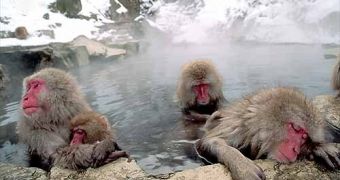The world "culture" has been used for centuries to differentiate people from animals. That's why many anthropologists, psychologists and philosophers refuse to apply this concept for the monkeys living in the cool mountains of Japan. Still, many researchers show behavioral and learning patterns to name these animals a "culture". If culture is the non-genetic transmission of habits and behaviors, or a unique pattern which distinguishes the traits of a perfectly defined community, we have to rethink this.
It all started in 1953 in the small island of Koshima (northern Japan). Ima, a one and a half year-old-female started to wash the received sweet potatoes from sand in the water. This way the potatoes proved to be tastier. Three years later, the same Einstein of the Japanese macaques made other discovery: when she submerged in the water wheat seeds mixed with earth, the seeds floated while the annoying soil remains sank.
In four and a half years, 20 % of the adults of the group and 80 % of the young had learned the Imo's techniques. In 1963, all the monkeys born after 1950 managed them, except one. The spread of the technique appeared to be a very cultural activity.
Imo died years ago, and all her contemporaneous macaques too, but the Koshima community still wash the potatoes and cleanse the seeds.
Of course, claiming that the Japanese macaques have a culture comparable to human one is like comparing the chicken's flight to a falcon's. Chickens do have weakly developed wings that helps them rich a low branch with a several grotesque flutters, but this has very little in common with a falcon's flight.
Since the '60s, the label of culture has been applied to many species, including the most notorious case, our closest relative, the chimp.
Japanese macaques are one of the few monkeys that can withstand winters with temperatures below 0o C, in snow conditions of the Japanese mountains (other known monkeys to do this are some macaque species from China and Himalaya, and golden monkeys-Rhinopithecus- from the mountains of China); still they do not live in the frozen island of Hokkaido (their areal is formed by the islands of Honshu, Shikoku, Kyushu and Takeshima archipelago). Moreover, they play with the snow.
They live in groups of 30-150 individuals and during winter, they snuggle into each other to get warm. In the large island of Honshu, some macaque populations have earned their fame for their habit of warming in the winter in thermal waters (in Shiga and Jigokudani "Hell's Valley", for example). They were even observed to practice some "physical activities" to get warm in winter.
In winter, the macaques can find cultivated fields, where they can easier find their food. In some areas there are regarded as pests and largely eliminated, but there are still about 35-50,000 individuals. Their greatest menace is the habitat loss (forest), as they sleep only up in the trees.
Studying their behavioral patterns, games, "wars", "politics", addictions, medicines, drugs, tools, dances, learning abilities, sexuality, mathematical abilities, space and time perception proved to be a box of surprises, and pointed out many elements that are common to humans.
Perhaps the most shocking in these monkeys is their general...homosexuality! In a Japanese macaque troop, females have strong bounds with each other and form temporary lesbian pairs during the mating season, ruling several partners during the whole period. They stimulate genitally each other and express their pleasure by cackling. That's why the links amongst females are extremely strong in a group.
In each group, there is an older strong dominant male, that will have primacy when it comes to mating. The other male macaques practice homosexuality, but do not form pairs, their contacts resuming to a one-night stand. Females usually have one offspring annually.

 14 DAY TRIAL //
14 DAY TRIAL //